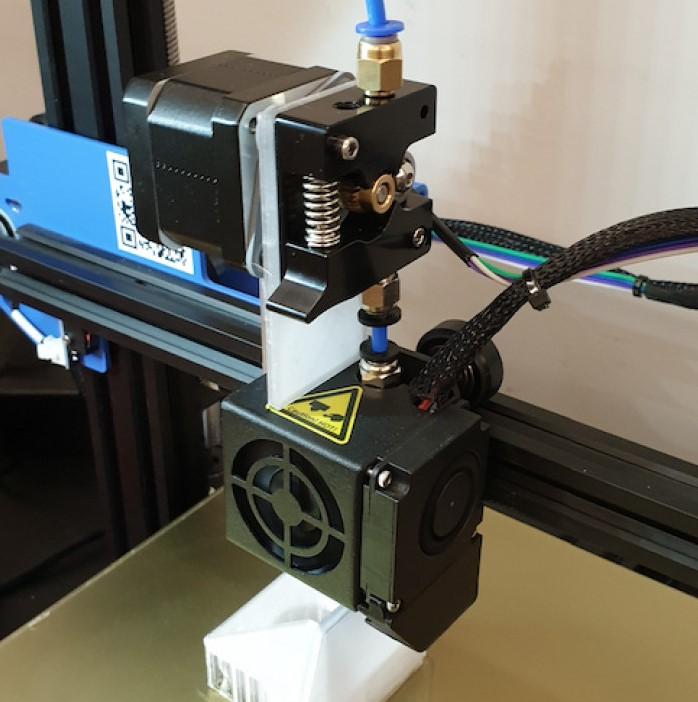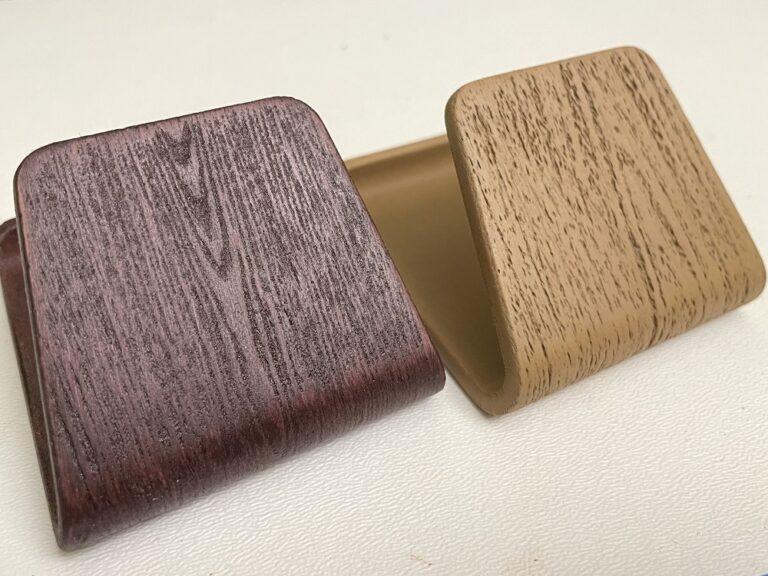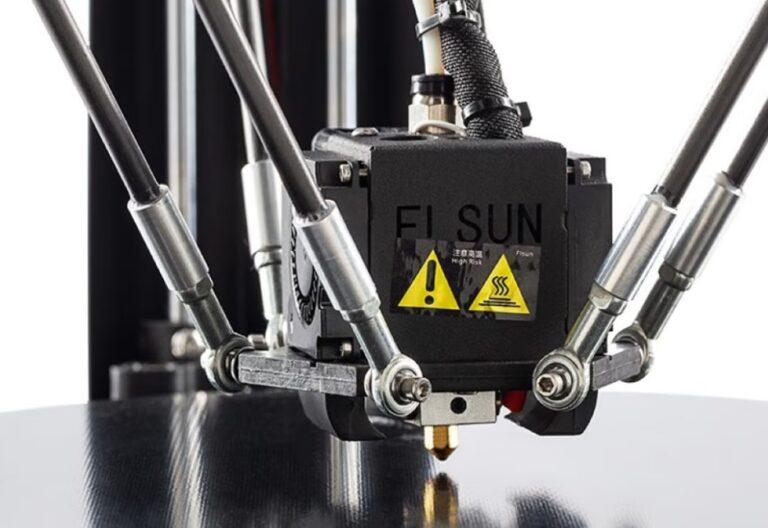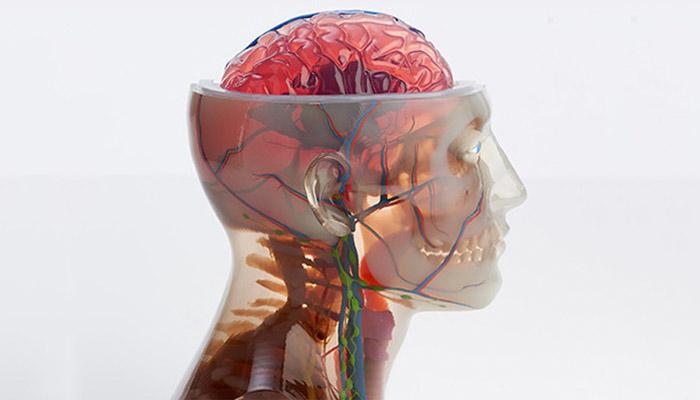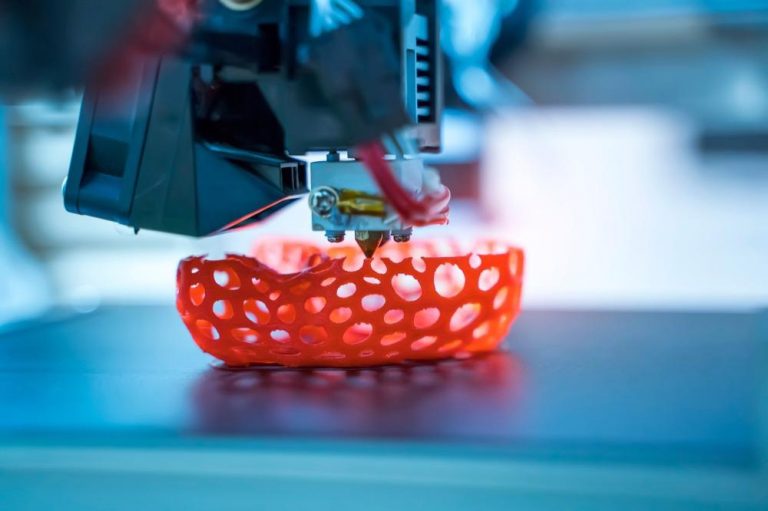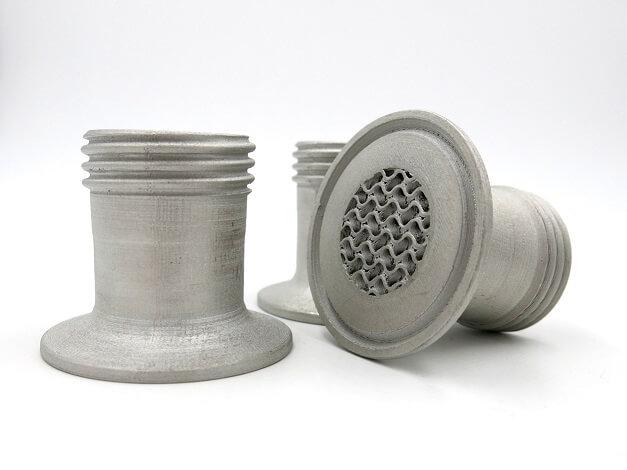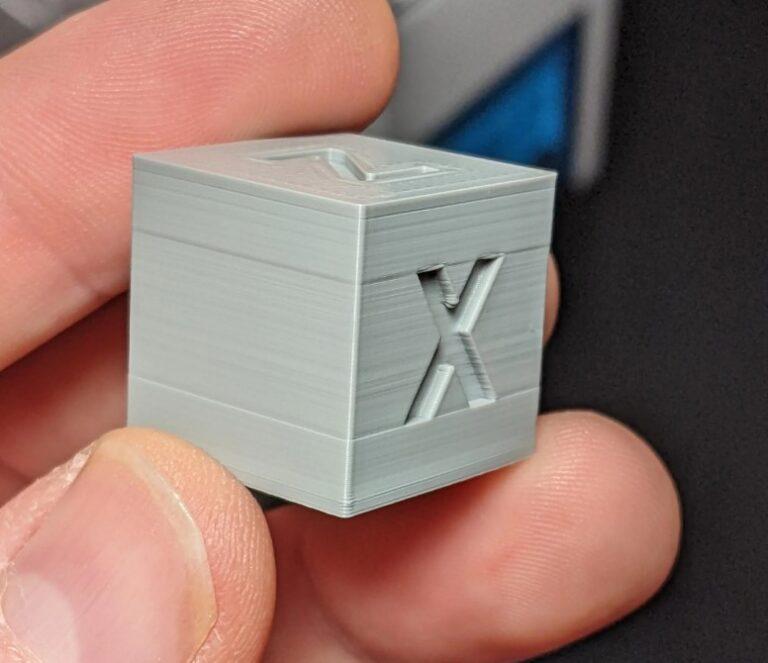Introduction
A 3D printer extruder is a crucial component in 3D printing technology. It is responsible for feeding the printing material into the hot end, which then melts and extrudes it onto the printing bed layer by layer. Different types of extruders are available, each with their unique features and capabilities. By understanding the various options, users can make informed decisions about which extruder is best suited for their printing needs.
In recent years, 3D printing technology has advanced significantly, with extruder technology being a major area of development. Manufacturers are now producing extruders with higher precision, speed, and accuracy than ever before. This has opened up new possibilities for creating complex and intricate 3D models. As a result, 3D printer extruders are now an essential component of various industries, including aerospace, automotive, and medical. Understanding the intricacies of extruders is critical for achieving high-quality prints and maximizing the potential of 3D printing technology.
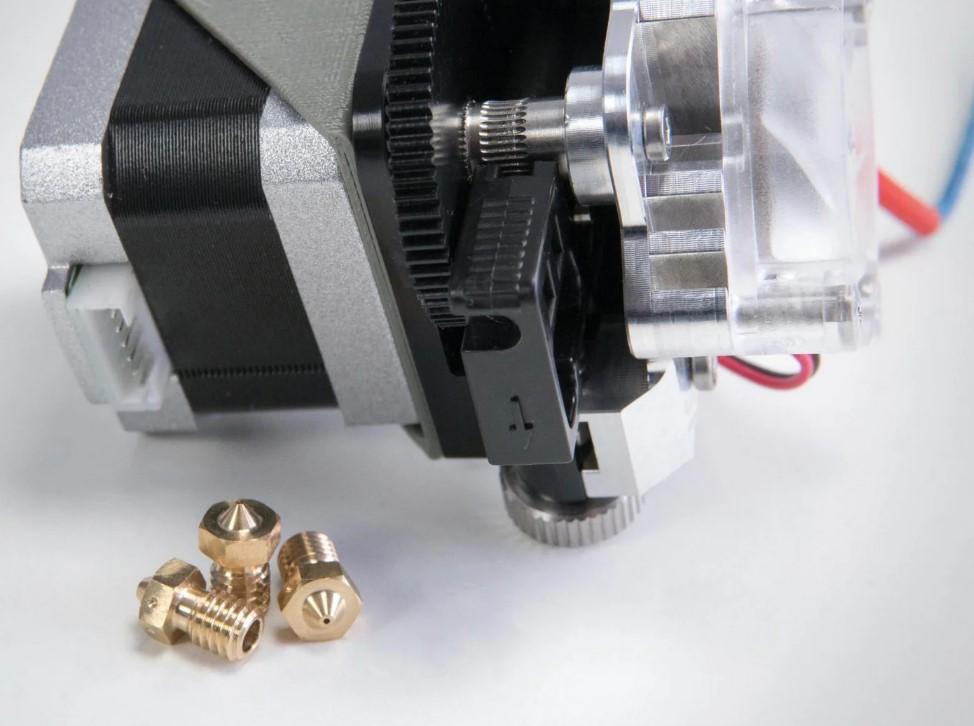
what is a 3D printer extruder?
The 3D printer extruder feeds printing material into the hot end. The material melts and extrudes layer by layer onto the bed. It is located on the printer frame and consists of a motor, driving gear, and heat sink.
The extruder holds filament in its driving gear. It moves towards the hot end. The filament melts and extrudes. The motor controls the gear’s speed and direction. It provides fine control over the amount and rate of filament fed into the hot end. There are various extruder types, each with special features like direct drive or Bowden setups, twin extrusion, and more. Achieving high-quality prints and utilizing the full potential of 3D printing technology requires an understanding of the extruder’s capabilities and limitations.
Importance of understanding extruders for successful 3D printing
To successfully print 3D objects, one must have a solid understanding of 3D printer extruders. The quality of the finished product, including the accuracy, precision, and strength of the print, can be significantly influenced by the extruder’s performance.
Selecting the right extruder for a given printing project might make all the difference. Consider filament compatibility, extruder type, and hot end compatibility for optimal printing results. Troubleshoot common extruder issues, maintain, clean, and upgrade for better performance. Learn about extruders to optimize 3D printing benefits and explore new possibilities for creativity and invention.
Types of 3D Printer Extruders
There are several types of 3D printer extruders available, each with unique features and capabilities. The most common types include direct drive extruders, Bowden extruders, geared extruders, delta extruders, and flexion extruders.
Direct drive extruders are mounted directly on the hot end, providing precise control over the extrusion process. Bowden extruders are mounted separately from the hot end, using a tube to feed the filament to the hot end. Geared extruders use a gear reduction system to provide high torque and precision. Delta extruders are used in delta-style 3D printers, where they move the hot end in a three-dimensional space. Flexion extruders are designed for high precision and are commonly used in medical and dental 3D printing applications. Understanding the strengths and limitations of each type of extruder can help users make informed decisions about which extruder is best suited for their printing needs.
By choosing the right type of 3D printer extruder, users can improve their print quality and achieve better results. The filament type, print complexity, and precision level affect the choice of extruder. Knowing the differences between extruder types can lead to creative and innovative printing. Understanding extruder features helps users choose the right one for their printing needs.
Direct drive extruders
A typical style of 3D printer extruder that is installed directly on the hot end is called a direct drive extruder. With this design, the extrusion process can be precisely controlled, and the filament can be managed more effectively. For printing with a variety of filaments, including flexible and soft materials, direct drive extruders are excellent. Nevertheless, direct drive extruders are often heavier than Bowden extruders, which can result in slower printing speeds and more wear and tear on the printer’s frame.
Direct drive extruders have a number of benefits over other extruder types, despite some possible downsides. More accuracy and precision in the finished print are made possible by their capacity to provide exact control over the extrusion process. Moreover, direct drive extruders offer more constant extrusion speeds, which lowers the possibility of filament jams or clogging. They are therefore perfect for printing detailed models and complicated artwork. Direct drive extruders can also be changed and modified to enhance their functionality and make them compatible with other filament types.
Achieving good 3D prints requires an understanding of the advantages and disadvantages of various 3D printer extruder types. Direct drive extruders offer advantages over Bowden extruders. They may not be suitable for all projects. The choice depends on variables like filament type, precision, accuracy, and printing speed. To improve print quality, users can experiment with different extruder types and fine-tune settings. Optimizing 3D printing technology is crucial.
Bowden extruders
A frequent kind of 3D printer extruder utilized in high-speed 3D printing applications is the Bowden extruders. Bowden extruders are mounted separately from hot end. They use a tube to deliver filament. This design allows lighter and quicker extruders. Distance between extruder and hot end can cause issues. Bowden extruders are more difficult to tune.
Notwithstanding their drawbacks, Bowden extruders have a number of benefits for particular 3D printing projects. Bowden extruders work well with soft and flexible filaments due to the reduced chance of jams. They’re also beneficial for large print jobs, as they’re quick and place minimal stress on the printer frame. However, users must be aware of possible issues and adjust their settings for optimal results.
Selecting the best kind of 3D printer extruder is essential for producing prints that are of a good caliber. Bowden extruders have several advantages over other extruder types, such as direct drive extruders, however, they might not be the ideal option for all printing projects. Unlocking the full potential of 3D printing technology requires an understanding of the advantages and disadvantages of various extruder types. Users can improve print quality and realize the full potential of 3D printing by taking the time to learn about the options available and experiment with various extruder types.
Geared extruders
Geared extruders are a popular type of 3D printer extruder that uses a gear reduction system to provide high torque and precision. This design allows for greater control over the filament, resulting in more accurate and precise prints. Geared extruders are great for flexible filaments with improved control and reduced clogging. They can be challenging to calibrate, needing more experience and expertise. These extruders offer better performance, higher flow rate, and increased torque. The complex design and calibration require more time and effort. They are suitable for printing with a variety of filaments, including nylon, TPU, and PETG.
Despite their potential challenges, geared extruders offer several advantages over other types of extruders. Their high torque and precision make them ideal for printing large or complex objects, where accuracy and consistency are critical. Geared extruders also provide more consistent extrusion rates, reducing the chances of filament jams or clogs. This makes them ideal for printing intricate designs and high-resolution models. Additionally, geared extruders can be modified and upgraded to improve their performance and adapt them to different types of filaments.
Selecting the right type of 3D printer extruder is key to achieving high-quality 3D prints. Geared extruders have advantages over other types. They may not suit every printing project. Understanding extruder strengths and limitations is crucial. Compatibility with different filaments is also important. Optimal print quality depends on these factors. Experimenting with extruders and fine-tuning settings is key. It unlocks new possibilities for 3D printing creativity and innovation.
Delta extruders
A typical type of 3D printer extruder seen in delta-style 3D printers is the delta extruder. More control over the print process is made possible by delta extruders, which move the hot end in three dimensions. Delta extruders typically have a motor, a drive gear, and a series of arms that move the hot end. Delta extruders are best for printing large or complex things where accuracy and precision are essential. The Delta extruders, on the other hand, might be trickier to calibrate and adjust than other extruder types, necessitating more skill and experience to use efficiently.
Delta extruders provide a number of benefits over other types of extruders, despite their possible drawbacks. Its three-dimensional movement enables better control over the printing process, producing prints that are more exact and precise. Delta extruders are also excellent for printing huge or complex things where precision and consistency are crucial. Delta extruders may also be changed and modified to increase their performance and make them compatible with other filament types.
Knowledge of the various 3D printer extruder types is essential to producing excellent prints. Delta extruders have advantages over other types. They may not be the best option for all projects. Choosing an extruder depends on factors like filament type and precision. Users can improve print quality by experimenting with extruder types and settings.
Flexion extruders
A particular kind of 3D printer extruder made for great precision and accuracy is called a flexion extruder. They are frequently utilized in 3D printing applications for the medical and dentistry fields, where the need for extreme accuracy and precision is crucial. Flexion extruders frequently employ a dual-drive system to provide the filament greater control, resulting in prints that are more accurate and precise. Due to their dual-drive arrangement, which lessens the possibility of filament jams or clogging, Flexion extruders are also excellent for printing with flexible and soft filaments.
Flexibility extruders may have advantages, but they can also be more difficult to calibrate and tune than other extruder kinds, necessitating more skill and experience to utilize properly. They may also cost more than other extruder kinds, which limits their appeal to amateurs and small-scale customers. Nonetheless, flexion extruders are a great option for those that demand the highest levels of accuracy and precision in their 3D printers.
Selecting the proper kind of 3D printer extruder is essential for producing excellent prints. Flexibility extruders provide several benefits over other extruder kinds, such as direct drive and Bowden extruders, but they may not be the ideal option for all printing projects. Achieving the best print quality requires a thorough understanding of the benefits and drawbacks of various extruder types as well as their compatibility with various filament types. Users can open up new opportunities for creativity and innovation in 3D printing by experimenting with various extruder types and fine-tuning their settings.
Factors to Consider When Choosing an Extruder
There are various things to take into account when choosing an extruder for 3D printing. The type of filament being utilized should be taken into account first. Extruders must be compatible with the filament being used since different types of filament require different types of extruders. The desired level of precision and accuracy is the second element to take into account. Some extruders are more suitable for printing with high levels of accuracy and precision, while others are better suited for printing quickly and effectively.
The project’s needed printing speed is another crucial issue to take into account. Some extruders are better suited for printing at high speeds, while others are better suited for printing at slower speeds. While selecting an extruder, it’s also important to take the complexity of the print job into account. Some extruders are better suitable for printing complex designs, while others are better suited for printing huge or straightforward objects.
While selecting an extruder, you should also take into account the cost of the extruder, the level of skill necessary to use it efficiently, and whether or not the extruder is compatible with your printer. Users may select the appropriate extruder for their unique printing requirements and get the greatest results by carefully considering each of these parameters.
Selecting the proper extruder is essential for producing good 3D prints. Users can choose an extruder that is most suited to their unique printing requirements by carefully examining the type of filament being used, the desired level of precision and accuracy, the required printing speed, and the complexity of the print project. Users can realize the full potential of 3D printing technology and improve print quality by taking the time to learn about various extruder types and experimenting with various settings and configurations.
Filament compatibility
Compatibility with filament is one of the most significant elements to take into account when choosing a 3D printer extruder. The physical characteristics of various filament types, such as melting point, flexibility, and diameter, can have an impact on how they interact with the extruder. As a result, it’s crucial to pick an extruder that works with the particular filament being used.
While some extruders are made to function with a variety of filaments, others are made to deal with a particular kind of filament, including flexible or high-temperature materials. To achieve optimum performance and print quality, it is crucial to select an extruder that is made to operate with the particular type of filament being used. Users should also take the filament’s diameter into account, since some extruders may be better suited to handling particular filament diameters than others.
Users should also think about the caliber and uniformity of the filament being used when choosing a 3D printer extruder. Poor-quality or inconsistent filament might interfere with extrusion, resulting in unsuccessful prints or prints of poor quality. To avoid moisture absorption and other problems, it is crucial to select high-quality filament from a dependable provider and to make sure that it is stored correctly.
When choosing a 3D printer extruder, filament compatibility is a crucial element to take into account. Users can attain the best performance and print quality by selecting an extruder that is made to operate with the particular type of filament being used. Users can further enhance their 3D printing outcomes and stay clear of frequent problems like failed prints and subpar print quality by taking the quality and consistency of the filament they are using into account.
Extruder type and drive mechanism
The type of extruder and its drive mechanism are crucial considerations when choosing a 3D printer extruder. Extruders come in a variety of designs, each with unique advantages and disadvantages, such as direct drive, Bowden, geared, and delta extruders. The extruder’s performance and ability to work with various types of filaments can also be impacted by the driving mechanism it employs, such as a single or dual drive.
Direct drive extruders are best for printing flexible or soft materials since they are located directly on the hot end and offer greater filament control. On the other hand, Bowden extruders employ a longer tube to send the filament to the hot end, allowing for quicker printing speeds but limiting filament control. Geared extruders are perfect for printing with a variety of filaments since they have great torque and precision thanks to a gear reduction mechanism. In contrast, delta extruders move the hot end in three dimensions using a series of arms, giving the user more control over the printing process.
It is crucial to choose an extruder that is suitable for the type of filament being used and to take into account the unique requirements of the printing project. Users should also take into account the level of skill needed to operate various extruder types, since some may be more complicated or difficult to calibrate than others.
Hot end compatibility
Another important factor to consider when selecting a 3D printer extruder is hot end compatibility. The hot end is the component of the printer responsible for melting and extruding the filament, and different types of hot ends may require different types of extruders. It is important to choose an extruder that is compatible with the specific hot end being used to ensure optimal performance and print quality.
Some extruders are designed to work with a wide range of hot ends, while others are designed for specific types of hot ends, such as those with higher or lower melting temperatures. It is important to choose an extruder that is designed to work with the specific type of hot end being used to avoid issues such as clogging or filament jamming.
When selecting a 3D printer extruder, users should also consider the level of expertise required to install and configure the extruder with the hot end. Some extruders may be more challenging to install or calibrate than others, requiring more experience or expertise to use effectively. Additionally, users should also consider the potential for upgrades or modifications to the hot end or extruder in the future, and choose components that are compatible with potential future upgrades.
Hot-end compatibility is an essential factor to consider when selecting a 3D printer extruder. By choosing an extruder that is compatible with the specific type of hot end being used, users can avoid issues such as clogging or filament jamming and achieve optimal print quality. By also considering the level of expertise required to install and configure the extruder with the hot end, users can ensure that they are able to effectively operate and maintain their 3D printing equipment.
Price and affordability
Price and affordability are important factors to consider when selecting a 3D printer extruder. Extruders can vary widely in price, with some models costing hundreds or even thousands of dollars. It is important to consider the overall budget for the 3D printing project and select an extruder that is within the desired price range.
When considering the price of an extruder, it is important to also consider the overall value it provides. Higher-priced extruders may offer additional features or better performance, which can result in higher-quality prints or increased efficiency. However, users should also consider whether these additional features or performance benefits are necessary for their specific printing needs, or if a more affordable extruder would suffice.
Additionally, users should also consider the potential for future upgrades or modifications to the extruder, and whether investing in a higher-priced model now could save money in the long run. It is also important to consider the cost of ongoing maintenance and replacement parts, as these costs can add up over time.
Price and affordability are important factors to consider when selecting a 3D printer extruder. By carefully considering the overall budget for the 3D printing project and the value provided by different extruder models, users can select an extruder that is both affordable and effective. By also considering the potential for future upgrades or modifications and the ongoing cost of maintenance and replacement parts, users can make an informed decision and maximize the value of their 3D printing investment.
User reviews and ratings
User reviews and ratings can be valuable resource when selecting a 3D printer extruder. Reviews from other users can provide insight into the performance, reliability, and ease of use of different extruders, helping users make informed decisions.
When reading user reviews, it is important to consider the overall sentiment and frequency of positive and negative reviews. A high number of positive reviews can indicate that an extruder is reliable and effective, while a high number of negative reviews can indicate issues with performance or reliability. It is also important to consider the specific use cases mentioned in the reviews, as different extruders may perform better for certain types of printing projects.
Additionally, users should also consider the credibility of the reviewers, as reviews from experienced 3D printing professionals or hobbyists may be more valuable than reviews from inexperienced users. It can also be helpful to seek out reviews from multiple sources to get a more well-rounded understanding of the extruder’s performance and user experience.
User reviews and ratings can be valuable resource for selecting a 3D printer extruder. By carefully considering the overall sentiment and credibility of reviews, users can gain insight into the extruder’s performance, reliability, and ease of use. By also seeking out reviews from multiple sources, users can make a more informed decision and maximize their chances of selecting an extruder that meets their specific needs.
Top 5 3D Printer Extruders and Their Features
In the world of 3D printing, the quality of the extruder is critical to the success of your prints. We have compiled a list of the top five 3D printer extruders and their standout features.
E3D Hemera
First on our list is the E3D Hemera, which boasts a dual drive gear system, giving it almost 100 N of pushing force on the filament, making it great for large 3D printers that require high flow rates. It also has a T-slot mounting system that allows for easy design and mounting of the extruder on virtually any 3D printer.
Bondtech BMG extruder
Second on our list is the Bondtech BMG extruder, one of the lightest extruders available on the market. It has an adjustable tensioner system that lets you fine-tune the tension of the drive gears on the filament, giving you complete control over the filament feed.
E3D Titan extruder
Third on our list is the E3D Titan extruder, which comes with a translucent case design and is also compatible with 2.85 mm filaments, making it a truly versatile 3D printer extruder. It is known for its simplicity and high-quality extrusion.
Micro Swiss Direct Drive Extruder
Fourth on our list is the Micro Swiss Direct Drive Extruder, which is an excellent upgrade for the Ender 3 3D printer, allowing for the printing of different filaments and improved print quality.
BIQU H2
Lastly, the BIQU H2 extruder has a 7:1 gear ratio and a streamlined heat dissipation structure, making it ideal for extended high-temperature printing. It offers excellent value by giving you high-temperature printing capabilities with a direct extruder setup at a budget price.
When choosing an extruder, it is essential to consider factors such as filament compatibility, extruder type, hot end compatibility, price, and user reviews and ratings. With the above top 5 3D printer extruders, you can be sure of a high-quality extrusion and improved print quality.
Table of Comparison: Features of Top 3D Printer Extruders in 2023
| Extruder Name | Extrusion Type | Filament Diameter | Gear Ratio | Weight | Standout Features |
|---|---|---|---|---|---|
| E3D Hemera | Direct/Bowden | 1.75 mm | 3.32:1 | 388g/327g | Over 100N of pushing force, optimized airflow circulation |
| Bondtech BMG | Direct/Bowden | 1.75 mm | 3:1 | 75g | Lightweight and compact design, high gripping force |
| E3D Titan | Direct/Bowden | 1.75 mm/2.85 mm | 3:1 | 125g | Self-cleaning hobbed gear teeth, small form factor |
| Micro Swiss Direct Drive | Direct | 1.75 mm | 1:1 | N/A | Plug-and-play design, adjustable filament grip |
| BIQU H2 | Direct | 1.75 mm | 7:1 | 211g | Dual gear extrusion, optimized heat dissipation system |
These extruders vary in their extrusion type, filament diameter, gear ratio, and weight. The E3D Hemera is the most powerful extruder with over 100N of pushing force and optimized airflow circulation. The Bondtech BMG is the lightest extruder with a high gripping force, making it suitable for high-speed printers. The E3D Titan is a versatile extruder that can handle both 1.75mm and 2.85mm filaments and has self-cleaning hobbed gear teeth. The Micro Swiss Direct Drive is a plug-and-play upgrade for the Ender 3, offering an adjustable filament grip and hardened tool steel gears. The BIQU H2 is a dual-gear extruder system with a high-temperature hot end and a 7:1 gear ratio, making it suitable for extended hours of high-temperature printing.
Comparison of Pros and Cons for Top 5 3D Printer Extruders in 2023
| Extruder | Pros | Cons |
|---|---|---|
| E3D Hemera | High pushing force, optimized airflow circulation | Does not include the Bowden adapter |
| Bondtech BMG | Lightweight and compact design, adjustable tensioner | Comes without a mounting bracket, comes without Bowden adapter |
| E3D Titan | Self-cleaning hobbed gear teeth, small form factor | Comes without a mounting bracket, comes without a Bowden adapter |
| Micro Swiss Direct | Plug-and-play design, adjustable filament grip | Bulky design, limited printer compatibility |
| BIQU H2 | Dual gear extrusion, optimized heat dissipation system | Short cable wire length, not an all-metal design |
Note: The pros and cons are subjective and based on various reviews and opinions.
Troubleshooting Extruder Problems
3D printer extruders can experience a range of problems that can affect the quality of your prints. Some of the common issues include under-extrusion, over-extrusion, jamming, grinding, and clogging. The good news is that most of these issues can be resolved by troubleshooting your extruder.
Common extruder issues and their causes
Common extruder issues and their causes are a frustrating reality for 3D printing enthusiasts. When the extruder fails, it can ruin an entire print or cause significant setbacks in production. Here are five common extruder issues and their causes that you should be aware of to avoid wasted time, filament, and money.
Filament Jamming
Filament jamming is one of the most common issues that 3D printer users face. It happens when the filament gets stuck in the extruder, which leads to under-extrusion or no extrusion. The primary cause of filament jamming is a clogged nozzle or feeding tube. Other factors that can contribute to jamming are excessive retraction, filament quality, and incorrect extruder temperature settings.
Under-Extrusion
Under-extrusion occurs when the printer fails to deliver the right amount of filament to the hot end. It leads to weak and incomplete prints with noticeable gaps and underfilled sections. The causes of under-extrusion can be a clogged nozzle, improper extruder tension, incorrect extruder temperature, or a damaged filament drive gear.
Over-Extrusion
Over-extrusion occurs when the printer delivers more filament than required to print an object. The excess filament leads to rough and sloppy prints with visible bumps and blobs. Over-extrusion is usually caused by incorrect filament diameter settings, incorrect extruder temperature settings, or incorrect flow rate calibration.
Grinding of Filament
Filament grinding happens when the extruder drive gear fails to grab the filament properly. The gear spins and grinds the filament, resulting in under-extrusion or no extrusion at all. Filament grinding can be caused by insufficient extruder tension, a damaged filament drive gear, or incorrect retraction settings.
Hot End Clogging
Hot end clogging occurs when the filament solidifies inside the hot end, preventing the smooth flow of the filament. It leads to under-extrusion or no extrusion at all. Hot end clogging can be caused by a clogged nozzle or feeding tube, incorrect extruder temperature settings, or low-quality filament.
extruder skipping
Extruder skipping is a common issue in 3D printing where the extruder motor makes a clicking or grinding sound and the filament fails to move through the nozzle properly. This can cause uneven extrusion, under-extrusion, and ultimately, failed prints. It typically occurs when the extruder motor is unable to push the filament through the hot end due to a blockage or other mechanical issue. Some common causes of extruder skipping include a clogged nozzle, improper tension on the filament, a worn out or damaged gear, or a faulty extruder motor. To fix the problem, the blockage needs to be cleared or the mechanical issue needs to be addressed.
How to diagnose and fix extruder problems
When you encounter problems with your 3D printer extruder, it can be frustrating and disruptive. However, there are steps you can take to diagnose and fix the issue.
One common problem is extruder clogs, caused by foreign debris or leftover filament in the nozzle. To fix this, you can try clearing the nozzle with a small wire or unclogging solution. Another issue is inconsistent filament feed, which could be due to a loose extruder gear or a worn-out drive mechanism. In this case, tightening or replacing the gear, or cleaning the drive mechanism, could solve the problem.
If you are experiencing under-extrusion, it could be due to a clogged or partially blocked nozzle or a problem with the extruder stepper motor. Cleaning or replacing the nozzle or adjusting the motor settings may be necessary. Additionally, filament slipping can occur when the filament is not gripping properly, caused by a loose drive gear or too much tension on the filament. Adjusting the tension or replacing the gear may solve the problem.
Lastly, extruder skipping is when the motor skips steps and causes gaps in the print. This could be due to a motor problem or a misaligned or worn-out drive gear. Adjusting or replacing the gear, or adjusting the motor settings, may be necessary.
Maintenance and Upgrades for Extruders
Maintaining and upgrading your 3D printer extruder can help ensure optimal printing performance and extend its lifespan. One of the most important maintenance tasks for extruders is keeping them clean. Filament residue, dust, and other debris can accumulate in the extruder and cause clogs or uneven extrusion. Regularly cleaning the extruder gears, drive train, and hot end can help prevent these issues.
In addition to cleaning, upgrading your extruder can also improve its performance. Upgrades such as replacing the stock plastic gears with metal ones or upgrading to a dual drive system can provide a better grip on the filament and reduce slipping or skipping. You may also consider upgrading to a more powerful extruder if you frequently print with high-flow filaments or need to increase your print speed. These upgrades can be a cost-effective way to improve the quality and reliability of your 3D prints.
Cleaning and lubrication
You must perform regular maintenance on your 3D printer extruder, including cleaning and lubricating. Lack of lubrication can result in extruder wear and tear, and a dirty extruder might affect print quality.
Remove any extra filament from the gears and nozzle before cleaning the extruder. To get rid of any dust or debris, use a tiny brush or compressed air. Use acetone or isopropyl alcohol as a solvent for tough dirt. It’s crucial to exercise caution when using solvent since too much of it can harm the extruder’s plastic components.
To maintain smooth functioning after cleaning, it is essential to oil the extruder. On the gears and the filament path, a small amount of lubricant can be applied. Choose a lubricant that is suitable for 3D printing filaments and compatible with the extruder’s substance. To avoid it drawing dust and debris, make sure you wipe off any extra lubrication. Your extruder’s lifespan can be extended and high-quality prints can be ensured with routine cleaning and lubrication.
Upgrading and replacing parts for better performance
Upgrading and replacing parts of your 3D printer extruder can help you achieve better performance and print quality. One upgrade you can consider is replacing the stock nozzle with a higher-quality one. Nozzles are available in different sizes and materials, and choosing the right one for your application can improve the extrusion process and reduce clogs. A hardened steel nozzle, for example, is better suited for printing with abrasive materials such as carbon fiber or metallic filaments.
Another part you can upgrade is the extruder drive gear. Upgrading to a high-quality drive gear can increase the grip on the filament, leading to better print quality and a reduction in filament slippage. A dual-drive gear system, such as the one used in the E3D Hemera extruder, is even more effective at reducing filament slippage and improving overall extrusion performance. Upgrading the extruder motor to a more powerful one can also be considered, especially if you are experiencing issues with filament skipping or under-extrusion.
In conclusion, upgrading and replacing parts of your 3D printer extruder can significantly improve its performance and print quality. Replacing the nozzle, drive gear, or motor with higher-quality alternatives can help reduce clogs, improve filament grip, and enhance the overall extrusion process.
Calibration and tuning for optimal printing
Calibration and tuning are essential for achieving optimal printing results with your 3D printer extruder. Proper calibration ensures that the extruder is working precisely, and the filament is feeding smoothly without under or over-extrusion. Additionally, it minimizes the risk of clogs and jams in the nozzle, resulting in high-quality prints. One of the most critical calibration factors is the extruder steps per millimeter. It determines how much filament is extruded for a specific amount of motor rotation. The extruder steps per millimeter can vary based on the filament’s diameter, extruder gear ratio, and other factors. Calibrating it correctly ensures that the printer can accurately push the correct amount of filament for precise printing.
Other essential factors to consider during calibration include bed leveling, nozzle height, and temperature settings. Proper bed leveling ensures that the printer nozzle is at the correct distance from the print bed, ensuring that the filament adheres to the bed correctly. The nozzle height determines the thickness of each layer, which impacts the print’s overall quality. Lastly, temperature settings affect the material’s flow and adhesion, so it’s important to ensure they are set correctly. With proper calibration and tuning, you can achieve high-quality prints and make the most out of your 3D printer extruder.
Conclusion
In conclusion, the 3D printer extruder is an essential part of the 3D printing process that plays a significant role in the overall print quality. To ensure optimal performance, it is essential to properly maintain and upgrade the extruder as necessary. Cleaning and lubrication are critical steps in maintaining the extruder and prolonging its lifespan. Additionally, upgrading and replacing parts can improve its performance and compatibility with various filaments. Calibration and tuning also play a vital role in achieving optimal printing results. By following proper calibration and tuning procedures, users can achieve high-quality prints with minimal issues.
Overall, selecting the right extruder for your needs and properly maintaining it can make a significant impact on your 3D printing experience. Whether you are a hobbyist or a professional, understanding the common issues that arise with extruders and how to troubleshoot them is essential to achieving successful prints. By staying up to date with the latest upgrades and advancements in extruder technology, users can continue to improve the quality of their prints and explore new possibilities in the world of 3D printing.
Summary of important points
In conclusion, the extruder is a crucial part of any 3D printer, and it is crucial to comprehend its functions, upkeep, and upgrades in order to get the best print quality. With the right troubleshooting skills, common problems like jams, skipping, and blockages can be quickly identified and fixed. The extruder can experience problems and last longer with routine cleaning and lubrication. The performance of the extruder can be considerably enhanced by replacing or upgrading components like the hot end or driving gears, which will lead to faster print times and higher print quality. To get the best printing results, the extruder must be calibrated and tuned.
While there are many extruder alternatives on the market, it is necessary to pick one that is compatible with the system and hot end of your 3D printer. Pricing and affordability are also essential factors, but choosing a less expensive choice over one of higher quality could lead to more issues and costs in the long run. The longevity and performance of the extruder can be extended through proper upkeep and modernization, improving the quality of the printing process.
Final thoughts on 3D printer extruders and their impact on 3D printing technology
Since the beginning of 3D printing, 3D printer extruders have advanced significantly. Technology developments have made 3D printer extruders more accurate, dependable, and effective. There is a solution for any 3D printing demand thanks to the range of extruders on the market. There is an extruder that will work for you, whether you require a direct or Bowden extrusion, a high-temperature or low-temperature extruder, or one that is lightweight or heavy-duty.
We may anticipate seeing many more developments in 3D printer extruders as 3D printing technology progresses. It is intriguing to consider how this technology may develop in the future and how it will affect sectors like manufacturing, healthcare, and aerospace. We may anticipate more cutting-edge extruder designs, quicker printing rates, and increased precision as the demand for 3D printing increases. We have only begun to scratch the surface of what 3D printer extruders can do, but they have a tremendous impact on the manufacturing industry.
How to choose the right extruder for your 3D printer
- Determine your printing needs
Consider the materials you want to use, the size of your prints, and the printing speed you desire. This will help you determine the type of extruder you need.
- Identify the extruder specifications
Check the extruder specifications such as filament diameter, extrusion type, and gear ratio, and make sure they are compatible with your 3D printer.
- Research the brand and model
Read reviews, check forums, and ask for recommendations from other 3D printing enthusiasts to identify the best brands and models for your needs.
- Compare features and prices
Compare the features and prices of different extruders to find one that offers the best value for your money.
- Consider additional features and upgrades
Consider additional features and upgrades, such as dual extrusion, all-metal hot ends, or direct drive systems, that may improve the performance of your 3D printer.
- Purchase and install the extruder
Once you have selected the right extruder for your needs, purchase it and follow the manufacturer’s instructions to install it on your 3D printer.
- Test and calibrate the extruder
Test the extruder by printing a calibration cube or other test print, and calibrate it if necessary to ensure optimal performance.
FAQs
A 3D printer extruder is the part of the 3D printer responsible for melting and extruding the filament material.
No, you cannot use any extruder with your 3D printer as each printer has its own compatibility requirements.
It depends on the usage of your 3D printer, but generally, it is recommended to clean and maintain your extruder every few months.
Yes, you can upgrade your existing extruder by replacing some of its parts or upgrading to a better model altogether.
The most important factor to consider when choosing an extruder is the compatibility of the extruder with your 3D printer.

